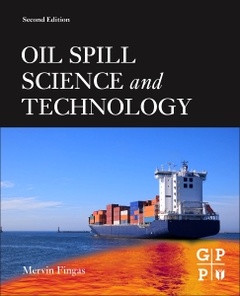Oil Spill Science and Technology (2nd Ed.)
Coordonnateur : Fingas Mervin

Oil Spill Science and Technology, Second Edition, delivers a multi-contributed view on the entire chain of oil-spill related topics from oil properties and behaviors, to remote sensing through the management side of contingency planning and communicating oil spill risk perceptions.
Completely new case studies are included with special attention to the Deepwater Horizon event, covering the impacts of wetlands and sand beaches, a mass balance approach, and the process for removing petroleum chemicals still trapped near Alabama beaches. Other new information on lingering oil left behind from the Exxon Valdez spill, the emergency system used in the Prestige incident, and coverage on the Heibei Spirit spill in Korea are also included.
This updated edition combines technology with case studies to identify the current state of knowledge surrounding oil spills that will encourage additional areas of research that are left to uncover in this critical sector of the oil and gas industry.
1. Spills and Risk Perceptions 2. Quantification of Oil Spill Risk 3. Oil Physical Properties: Measurement and Correlation 4. Chemical Fingerprints of Crude Oils and Petroleum Products 5. Oil Spill Remote Sensing 6. Oil Spill Detection Using Spaceborne SAR imagery: A New Era of Sentinel-1 7. Laser Fluorosensors 8. Introduction to Oil Spill Modeling 9. Response in Fast Currents 10. In-situ Burning: An Update 11. Shoreline Countermeasures 12. Bioremediation of Oil Spills on Land 13. Sunken and Submerged Oil 14. Oil Pollution in Antarctica 15. DeepWater Horizon Well Blowout Mass Balance 16. Assessing the Increase in Background Oil Contamination Levels Along Alabama's Beaches Resulting from the Deepwater Horizon Oil Spill 17. Remote Sensing of Oil Slicks for the Deepwater Horizon Damage Assessment 18. The Hebei Spirit Oil Spill, 2007 19. Health Aspects of the Hebei Spirit Oil Spill 20. Effects of Oil in the Environment
He has authored over 1,000 technical publications including books, manuals, and 500 peer-reviewed papers. He has won over 20 awards for research and papers from the United States Government, Canadian Government, and international conferences. He has served on two committees on the National Academy of Sciences of the United States on oil spills and as chairman of several ASTM and inter-governmental committees on spill matters, was the founding chairman of the ASTM sub-committee on in-situ burning and chairman of oil spill treating agents and another on oil spill detection and remote sensing. Dr. Fingas has collaborated on studies with over 25 organizations around the world, coordinated studies for over 30 years through 6 internationally attended committees and developed co-operative projects with many international groups
- Updated with new chapters on risk analysis and communication, contingency planning, restoration, and case studies
- Supported with technological advances evolved from the Deepwater Horizon/BP oil tragedy and events in the Arctic/Antarctic
- Multi-contributed from various industry experts to provide an extensive background in technical equipment and worldwide procedures used today
Date de parution : 12-2016
Ouvrage de 1078 p.
15x22.8 cm
Épuisé
Thèmes d’Oil Spill Science and Technology :
Mots-clés :
Antarctica; Background oil levels; Beach contamination; Bioaugmentation; Biomarkers; Bioremediation; Biostimulation; Burn emissions; Burning; Channel flow; Cleanup; Clean-up; Copernicus maritime surveillance; Crude-by-rail; Dams; Deepwater Horizon damage assessment; Deepwater Horizon mass balance; Deepwater Horizon remote sensing; Deepwater Horizon; Density; Disasters; Emulsification; Evaporation; Experts; Explosion; Exxon Valdez; Fast currents; Fast water; Fate of deepwater Horizon oil; Fire; Fish embryos; Forensic; Fuel; GC�MS; Health effects; Hebei Spirit oil spill; Hebei Spirit; Hydrocarbons; In situ burning; In situ treatment; LAPIO; Laser fluorosensors; Long-term health survey; Macondo mass balance; Marine mammals; Marine pollution; NRDA; Oil combustion; Oil detection; Oil effects; Oil fingerprinting; Oil properties; Oil spill behavior; Oil spill damage assessment; Oil spill detection; Oil spill modeling; Oil spill remote sensing; Oil spill risk; Oil spill; Oil toxicity; Oil treatment; PAHs; Petroleum; Physical properties; Preparedness; Refined petroleum products; Remediation; Resilience; Response in rivers; Response strategies; Response; Risk communication; Risk mitigation; Risk perception; SCAT; Sea turtles; Sensors for oil; Shipwrecks; Shoreline contamination; Shorelines; Social media; Southern ocean; Spill trajectory; fate; and effects modeling; Submerged oil; Sunken oil; Synthetic aperture radar; Tar balls; Toxicology; Trust; Vessel spills; Viscosity; Well blowouts



